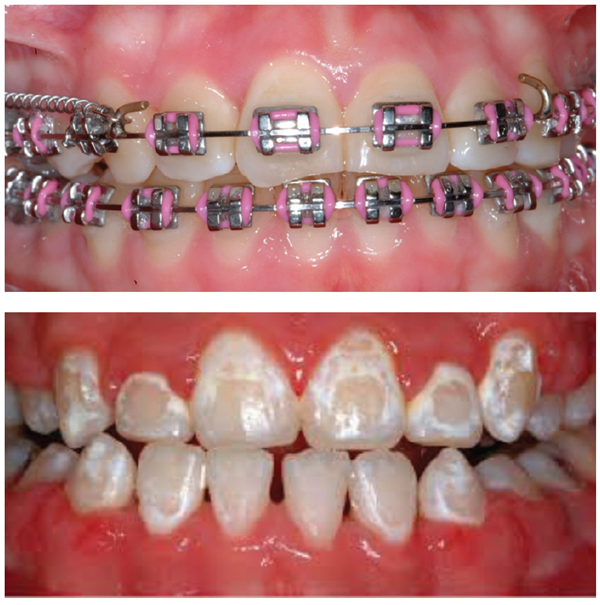How To Reduce White Spots During Orthodontic Treatment

White spot lesions due to demineralisation of tooth enamel are a common side-effect of orthodontic treatment, and a potential precursor to caries. The use of products based on bioactive glass which forms fluorapatite to remineralise the tooth surface could reduce the risk of white spot lesions in these patients.
Orthodontic treatment has never been more popular. With the current emphasis on oral aesthetics, not only teenagers but adults are seeking to improve the alignment of their teeth for a perfect smile.
There can, however, be an unfortunate ill-effect to the use of bonded orthodontic appliances: demineralisation of the tooth enamel around the brackets, ie white spot lesions (WSL). WSL are defined as ‘subsurface enamel porosity from carious demineralisation’, which are visible as a milky white opacity on the tooth surface, slightly softer than the surrounding smooth enamel.
The Research
An evaluation of the incidence and prevalence of white spot lesion formation during orthodontic treatment (Sundararai et al, 2015) found that 45.8% of the patients reviewed developed new WSL during treatment, and a total of 68.4% were found to have WSL at the time of evaluation. A key cause of the formation of WSL is the difficulty of maintaining oral hygiene around the brackets and wires, which also limit naturally self-cleaning mechanisms such as movement of the oral musculature and saliva, leading to a lowering of pH and starting the demineralisation process. Demineralisation can also occur due to acid erosion, for example due to the consumption of fizzy drinks.
Two initial stages have been observed in the development of WSL: surface softening – most pronounced at the enamel surface, and subsurface lesions, demineralisation developing in the deeper enamel where mineral is being lost. And demineralisation matters, because it is considered to be the precursor to frank enamel caries.
Much research has gone into developing solutions to halt demineralisation before caries can develop, and even to reverse it by remineralising the area affected. Fluoride has been shown to be extremely effective in the prevention of caries, but it seems that simply increasing the concentration of soluble fluoride in therapeutic toothpastes is not necessarily the best solution – much of it is still rinsed away by saliva within a short time.
An innovative new product, Biomin F, takes a different approach to the delivery of fluoride. Based on the use of bioactive glass originally developed for bone grafting, the structure of Biomin F incorporates fluoride, calcium and phosphate together, which as the glass dissolves are slowly released so that they work in concert with the saliva to restore the pH equilibrium and start the remineralisation process. This effect continues for around 12 hours and even up to 24 hours in some cases.
This slow release approach of fluoride, calcium and phosphate enables the production of fluorapatite, the fluoride analogue of natural tooth mineral. Fluorapatite has been shown to be more stable and resistant to acid conditions than hydroxyapatite, formed by earlier generations of bioactive glass, and studies in artificial saliva have shown that it starts to be formed within an hour after brushing with Biomin F.
Biomin F has an additional ‘smart’ effect. It starts to dissolve more quickly in acidic conditions, working harder to restore the pH balance and halt potential demineralisation, while a polymer within the paste holds it in place on the tooth, where the remineralisation action is most needed.
Research is ongoing to discover further innovative uses for Biomin technology. A resin for bonding orthodontic appliances containing the bioactive glass is undergoing trials, designed to release fluoride slowly while it is bonded to the teeth, and further applications are being considered.
In the meantime, clinicians can help patients to prevent and reverse white spot lesions by recommending Biomin F during orthodontic treatment – restoring the pH balance and remineralising tooth enamel.
Reference
Sundararai D et al (2015). Critical evaluation of incidence and prevalence of white spot lesions during fixed orthodontic appliance treatment: Meta-analysis. J Int Soc Prev Comm Dent. Nov-Dec 5(6): 433–439

